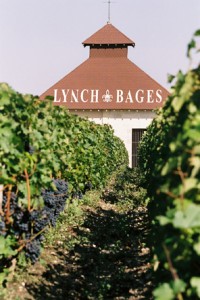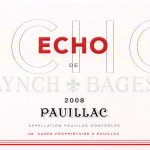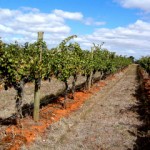The Cazes family business
Fifth growth Château Lynch-Bages (or ‘Lunch Bags’ to some of its irreverent anglophone friends) is one of the most celebrated châteaux in Bordeaux. Despite its ‘lowly’ classification, it is known as one of the ‘super-seconds’ – châteaux that regularly and consistently outperform their ranking in the 1855 classification.

Lynch Bages
This is in large part due to the long dedication of the Cazes family. It was Jean-Michel Cazes’ grandfather, Jean-Charles Cazes, who bought Lynch-Bages in 1939, after he’d already been running the estate for six years.
Jean-Michel joined the business in the early 1970s, and immediately set about restructuring the vineyards and winery over the next decade, setting the scene for the rise of the château. Another new phase of stewardship is evolving as Jean-Michel’s son, also Jean-Charles, took over the management of the château at the end of 2006.
Château Lynch-Bages and Pauillac
Lynch-Bages is located just outside the tiny hamlet of Bages, south of Pauillac town itself. It got its name back in 1749, when Thomas Lynch, descendant of an Irish émigré married the daughter of the owner of the then Domaine de Bages. One of his sons gave the name to the family’s Bordeaux branded wine, Michel Lynch, which is a one-million-bottle brand.
The property remained under Lynch family ownership until 1824. After a couple of changes of ownership, it came to the Cazes family.
The commune of Pauillac is a mother-lode of top terroir in the Médoc. Seventy percent of the appellation vineyards are classed growth, and include three of the five first growths (Lafite, Latour, Mouton-Rothschild).
The vineyards are made up of two low-lying plateaus of gravel beds which are deeper and higher than any others in the Médoc. They reach a grand 30m above sea level.
With 90 hectares, Lynch-Bages is one of the largest of the classed growth châteaux. In true left bank style, the vineyards are dominated by cabernet sauvignon plantings, 73%, with 15% merlot, 10% cabernet franc and 2% of petit verdot, a very late-ripening variety which is gaining more popularity on the left bank. As a little bit of seasoning in the blend it adds concentration of colour, piquancy and dense, black-fruited spice, bramble and blueberry.
Not that the wine itself mirrors the vineyard plantings. Each year, Daniel Lhose, the technical director, and his team, make a bench blending to determine which plots of land and which grape variety proportions will best express the vintage potential of that year.

Sylvie Cazes
Lynch-Bages is one of those wines that is a quintessential example of both Bordeaux and Pauillac. The archetype is power with elegance and a rich core of blackcurrant, showing fineness and finesse. Tannins are firm, liquid concentrated and sweet, with pencil shavings, perfume and polish.
The other stalwart of the Cazes family is Sylvie Régimbeau-Cazes, sister of Jean-Michel, who directs the global marketing and communications for the family properties. She said: “terroir is really important, and what proprietors make of their terroir. What is most important for us is to give the best care to such a great vineyard that was given to us – the care of the vines, tight pruning, the selection are all important to us to enhance the quality of the grape.” The aim, she added is “well structured wines with great fruit, elegance, elegant tannins and the best balance.”
The second wine
Not to be confused with the 1855 ‘second growth’ ranking, classed growths usually make what is called a ‘second wine’, in effect a baby brother of the ‘grand vin’, the latter which is the wine of the Château label.

Lynch Bages Echo
Very often the second wine can be an affordable introduction to the ‘house style’ of the grand vin. Château Haut-Bages Averous was bought by the Cazes family in 1973 and became the name of their second wine up to the 2007 vintage, generally using fruit from young vines – those from 3 to 12 years old.
Sylvie said: “the proportions vary each year, it’s usually about one-third second wine, two-thirds grand vin.” And it is likely to have slightly higher proportions of merlot and cabernet franc than the grand vin.
From the 2008 vintage, Château Haut-Bages Averous changed its name to Echo de Lynch-Bages, creating an emotive as well as visual link to the grand vin.
Gastronomy
The family’s move into gastronomy, Sylvie said “was a deliberate strategy. There was no good table in the area, so we decided to do our own.” In 1985 Pauillac Château Cordeillan-Bages was added to the portfolio. The 18th century monastery was renovated and is a Relais & Châteaux hotel with a two-Michelin star restaurant under chef Thierry Marx. There is also two hectares of vineyard, made into wine under the château name.
The family’s historic Le Chapon Fin restaurant in the centre of Bordeaux was added in 2001.
The hamlet of Bages
One of Jean-Michel’s latest achievements before he retired at the end of 2006 was to restore the hamlet of Bages, where he grew up. There’s a bakery, named after his and Sylvie’s grandmother, Au Baba d’Andréa, a relaxed family-style café and bistro – Café Lavinal – and the Bages Bazaar, which sells wines as well as wine and dining paraphernalia.
Venturing further afield

Jean Charles Cazes
From its stronghold in Bordeaux, the Cazes family have expanded to the Rhône Valley and the Languedoc. Sylvie said: “In the French estates we wanted to find estates with good and great potential, which could be some of the leaders of their appellations. We’ve achieved this with Ostal and Sénéchaux.”
It’s at these properties that Sylvie says Jean-Charles is focusing his early attention. “Jean-Charles is working a lot at L’Ostal and Sénéchaux, to restructure the vineyard, and to reflect on what to do with the wines and how to select them. The last few vintages have been really interesting, with lots of potential, and we’re growing in quality.”
They’ve also been developing joint ventures with experts and friends in other parts of the world, including Australia. Tapanappa is a venture with Brian Croser and the Bollinger Champagne family. And Xisto (pronounced ‘shis-toe’), after the schist soils of the Douro valley in Portugal, is a collaboration with the renowned Quinta do Crasto.

Tapanappa
This is a family that doesn’t stand still – they’re unlikely to turn down the right opportunity.
Cazes family businesses at a glance – Domaines Jean-Michel Cazes
- Château Lynch-Bages Pauillac
- Château Haut-Bages Averous (Lynch-Bages second wine)
- Blanc de Lynch-Bages. Bordeaux AC. The white wine of Lynch-Bages
- Château Cordeillan-Bages Pauillac
- Château Les Ormes de Pez St. Estephe
- Château Villa Bel-Air Graves
- Michel Lynch Bordeaux branded wine
- Le Chapon Fin Restaurant in centre of Bordeaux
- Domaine des Sénéchaux. Châteauneuf-du-Pape, Rhône Valley
- L’Ostal Cazes Minervois La Livinière, Southern France
- Tappanappa (with Brian Croser and Champagne Bollinger, in Australia)
- Xistu (with Quinta do Crasto, in Portugal)
- Ecole du Bordeaux. (not to be confused with the Ecole du Vin, known in English as the Bordeaux Wine School, run by the CIVB)
- Bordeaux Saveurs. Wine and leisure tours in Bordeaux, not just to Cazes family properties.



